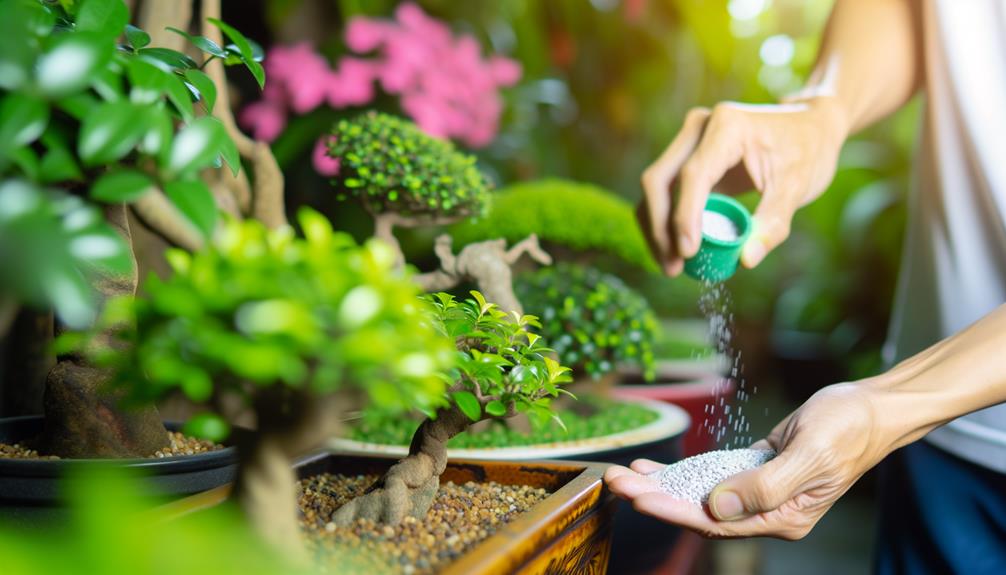How to Use Bonsai Fertilizer Safely on Other Plants
Yes, using bonsai fertilizer on other plants is possible, but proceed with caution. Bonsai fertilizers are formulated with specific nutrient ratios and slow-release mechanisms tailored for the confined soil environments and limited root systems of bonsai trees.
These fertilizers often contain higher levels of micronutrients like iron and manganese, which can lead to nutrient imbalances and phytotoxicity in non-bonsai plants. Dilute the fertilizer by 50% and monitor plant response closely to mitigate risks.
Understanding the unique nutrient composition and release mechanisms is key to ensuring plant health and avoiding potential adverse effects. Exploring further can provide deeper insights.

Key Takeaways
- Bonsai fertilizers have lower nutrient concentrations, suitable for plants with similar nutrient needs.
- High levels of micronutrients in bonsai fertilizers can cause toxicity in non-bonsai plants.
- Slow-release formulations may result in nutrient deficiencies or accumulation in other plants.
- pH levels in bonsai fertilizers may disrupt the soil chemistry of other plant species.
- Dilute bonsai fertilizer by 50% and monitor plant response to avoid over-fertilization.
Understanding Bonsai Fertilizer

Bonsai fertilizer is specially formulated to meet the unique nutritional needs of bonsai trees, which differ significantly from those of other plant species. These formulations are carefully designed to support the growth and health of bonsai within limited root systems and confined soil environments.
The specific nutrient ratios and slow-release mechanisms ensure that essential elements such as nitrogen, phosphorus, and potassium are available in precise amounts over extended periods. Additionally, trace elements and micronutrients are incorporated to address deficiencies that might arise due to the restricted growing medium.
This specialized approach caters to the delicate balance required for bonsai health, promoting robust root development, foliage density, and overall importance, which are crucial for maintaining the intricate artistry of bonsai cultivation.
Nutrient Composition
The nutrient composition of bonsai fertilizer is carefully calibrated to cater to the specific requirements of bonsai trees, providing a balanced mix of macronutrients, micronutrients, and trace elements essential for ideal growth and health. This specialized formulation guarantees optimal nutrient uptake and supports the unique physiological needs of bonsai.
Key components include:
- Macronutrients: Nitrogen (N), Phosphorus (P), and Potassium (K), which are essential for overall plant health, root development, and disease resistance.
- Micronutrients: Iron (Fe), Manganese (Mn), and Zinc (Zn), which play crucial roles in enzymatic functions and chlorophyll production.
- Trace Elements: Boron (B), Copper (Cu), and Molybdenum (Mo), which are necessary in very small quantities but important for metabolic processes and cellular function.
This precise nutrient balance is designed to support bonsai's compact and controlled growth.
Comparing Fertilizers

To thoroughly compare fertilizers, it is essential to evaluate the differences in nutrient composition, as bonsai fertilizers typically contain a unique balance tailored for miniature trees.
Additionally, analyzing the application methods reveals how the delivery and absorption of nutrients vary across different types of fertilizers.
Examining these aspects provides critical insights into the suitability and efficacy of bonsai fertilizers for other plant varieties.
Nutrient Composition Differences
Understanding the nutrient composition differences between bonsai fertilizers and conventional plant fertilizers is essential for determining their suitability for various plant species. Bonsai fertilizers are specifically formulated to support the unique growth requirements of miniature trees, often having a balanced ratio of macronutrients (N-P-K) and essential micronutrients. Conventional fertilizers, however, exhibit a broader spectrum in nutrient ratios to cater to different plant needs.
Key differences include:
- Nutrient Balance: Bonsai fertilizers often have lower concentrations to prevent root burn and promote slow, steady growth.
- Micronutrient Content: They typically contain higher levels of trace elements like iron, manganese, and zinc.
- Release Mechanisms: Bonsai fertilizers frequently use slow-release formulations to match the extended watering cycles of bonsai care.
These distinctions underscore the importance of selecting the appropriate fertilizer for optimum plant health.
Application Methods Comparison
Comparing the application methods of bonsai fertilizers and conventional fertilizers reveals significant differences that impact nutrient delivery efficacy and plant health outcomes.
Bonsai fertilizers are typically applied in dilute concentrations to avoid root burn and ensure controlled nutrient release, often utilizing slow-release pellets or liquid formulations. This method guarantees precise nutrient management tailored to the confined root systems of bonsai trees.
In contrast, conventional fertilizers are generally applied in higher concentrations, either as granules or liquid feed, to support the larger biomass of non-bonsai plants. This can result in rapid nutrient uptake but may also increase the risk of nutrient leaching and root damage if not carefully managed.
Consequently, understanding these application nuances is critical for optimizing plant health across different horticultural practices.
Benefits for Other Plants
Bonsai fertilizers are well-regarded for their balanced nutrient profiles, providing significant advantages when used on other plants.
These benefits include enhanced nutrient absorption due to their formulation, which is designed to be readily available to plant roots, and improved soil quality through the addition of essential micronutrients.
Moreover, their versatile application methods, such as liquid or slow-release granules, make them adaptable for various horticultural practices.
Enhanced Nutrient Absorption
Using bonsai fertilizer on other plants can greatly improve nutrient absorption because of its balanced combination of necessary macro and micronutrients customized for ideal plant health. This specialized formulation guarantees that essential elements such as nitrogen, phosphorus, and potassium are readily available, enhancing uptake efficiency.
- Balanced Macronutrient Ratios: Bonsai fertilizer typically contains precise ratios of N-P-K, facilitating efficient growth and development.
- Micronutrient Enrichment: The inclusion of trace elements like iron, manganese, and zinc in bonsai fertilizers ensures that plants receive complete nutritional support.
- Chelated Nutrients: Many bonsai fertilizers incorporate chelated forms of nutrients, which are more easily absorbed by plant roots, leading to improved overall health and vigor.
These attributes collectively enhance nutrient absorption, promoting strong growth in a variety of other plant species.
Improved Soil Quality
Beyond enhancing nutrient absorption, the use of bonsai fertilizer can greatly improve soil quality, benefiting a diverse range of plants through its advanced formulations. These fertilizers often contain micronutrients, beneficial microorganisms, and organic matter, which collectively enhance soil structure and microbial activity.
Improved soil aeration and water retention capabilities are crucial outcomes, fostering robust root growth and plant health. The slow-release nature of bonsai fertilizers guarantees a consistent supply of essential nutrients, minimizing leaching and nutrient loss.
Empirical studies have demonstrated that soils enriched with bonsai fertilizer exhibit increased cation-exchange capacity and organic carbon content, essential for sustainable plant development. Consequently, utilizing bonsai fertilizer can lead to long-term improvements in soil fertility, promoting a healthier and more resilient plant ecosystem.
Versatile Application Methods
Leveraging the versatile application methods of bonsai fertilizers can offer significant agronomic benefits to a wide array of plant species. These specialized fertilizers are formulated to provide balanced nutrition, thereby improving plant health and productivity across different taxa. Their adaptability in application methods allows for optimized nutrient delivery.
- Foliar Application: This method enables rapid nutrient uptake through leaves, enhancing immediate growth responses.
- Soil Integration: Incorporating bonsai fertilizer into the soil can improve root development and overall soil health, fostering robust plant growth.
- Water-Soluble Solutions: Using these fertilizers in irrigation systems ensures uniform nutrient distribution, promoting consistent plant development and reducing deficiencies.
Evidence supports these methods as effective means to elevate plant health and yield across diverse horticultural contexts.
Potential Risks

Applying bonsai fertilizer to non-bonsai plants can pose several risks due to the specialized nutrient formulations designed specifically for the unique requirements of bonsai trees.
The high concentration of micronutrients and trace elements, such as iron and manganese, may lead to nutrient imbalances in other plants. Excessive application can result in phytotoxicity, manifesting as leaf burn, stunted growth, or root damage.
Moreover, the slow-release nature of many bonsai fertilizers might not align with the metabolic demands of non-bonsai plants, causing either nutrient deficiency or accumulation.
Additionally, the specific pH levels targeted by bonsai fertilizers could disrupt the soil chemistry, adversely affecting nutrient uptake. Thus, cautious consideration is imperative when contemplating the use of bonsai fertilizers on other plant species.
Application Tips
To mitigate the risks associated with using bonsai fertilizer on other plants, it is critical to adhere to specific application guidelines.
First, understanding the nutrient composition of the bonsai fertilizer is essential. Bonsai fertilizers are often more concentrated in micronutrients and may have different N-P-K ratios compared to general-purpose fertilizers.
Second, dilution is imperative; a 50% dilution can prevent nutrient burn and over-fertilization.
Finally, monitor plant response closely. Different plants have varying nutrient requirements, and observing foliage and growth patterns will aid in making necessary adjustments.
- Understand Nutrient Composition: Analyze the specific ratios and micronutrient content.
- Dilute Appropriately: Use a 50% dilution to avoid over-fertilization.
- Monitor Plant Response: Regularly check for signs of nutrient burn or deficiencies.
Conclusion
The utilization of bonsai fertilizer on non-bonsai plants reveals a nuanced interplay of nutrient composition, benefits, and potential risks. Coincidentally, while bonsai fertilizers can enhance growth due to their tailored nutrient profiles, over-application or inappropriate use may lead to adverse effects.
Comparative analysis indicates that with careful application, bonsai fertilizers can be beneficial for various plant species. In this way, understanding the specific needs of each plant and the properties of the fertilizer is essential for achieving best growth outcomes.






